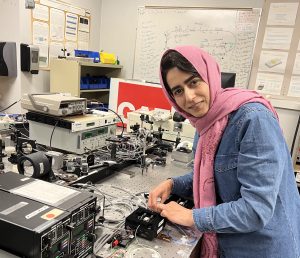
University of Central Florida researchers are part of a team who have revealed, for the first time, the intricacies of how light behaves in advanced dynamical optical systems with configurations known as non-Hermitian arrangements.
In non-Hermitian systems, allowed energy values create self-intersecting surfaces with a unique topology and branch points, which are known as exceptional points. The surfaces cross into each other at a twist, designated by an exceptional point.
The team found that the topology of an energy surface in a non-Hermitian arrangement plays more of a role in how light behaves in a time evolving system than strict winding around an exceptional point. This includes behaviors such as chiral state transfer, in which an output state is locked to the direction of winding, either clockwise or counterclockwise.
The findings, which were published recently in the journal Nature, could spur the development of novel mechanisms for light manipulation and promise profound implications for technologies such as miniaturized and robust lasers and high-precision light-based sensors.
The researchers made their observations by building a novel and multifaceted photonic emulator that allowed them to monitor the evolution of pulsed laser light in the system when it slowly varies along a closed path in the proximity of an exceptional point.
“The optical emulation platform that was realized can be used to model some of the most perplexing physical phenomena in nature,” says study co-author, Mercedeh Khajavikhan, a professor of physics and electrical and computer engineering at the University of Southern California.
The experimental observations challenge previous demonstrations but support recent theoretical predictions by Khajavikhan and study co-author Demetrios Christodoulides, the Cobb Family Endowed Chair and Pegasus Professor of Optics at the University of Central Florida’s CREOL- College of Optics and Photonics.
Their predictions have shown that the output of a non-Hermitian optical system — irrespective of its input — gets funneled into one of the two predefined states, depending on the direction in which a closed trajectory takes place dynamically in the vicinity or around an exceptional point.
“Other studies have looked at only what happens in the input and output of the system,” says the study’s lead author, Hadiseh Nasari, a postdoctoral associate with the University of Southern California and UCF’s CREOL- College of Optics and Photonics, where the work was performed. “They were not able to see what happens in the course of the process.”
“Our emulator is quite versatile in terms of the possibility of actually monitoring and digging into the dynamics of non-Hermitian systems close to an exceptional point,” she says.
Christodoulides says the fundamental work is a major step toward harnessing the potential of these systems.
“By better understanding the underlying physics of non-Hermitian systems, we will be able to engineer the variations of energy loss and gain which is needed for the realization of integrated but efficient and powerful optical technologies,” Christodoulides says.
Khajavikhan notes the technical skill that was needed to perform the study and the future research avenues it opens.
“This challenging work was led by three female postdocs and graduate students — Hadiseh, Gisela Lopez-Galmiche and Helena E. Lopez-Aviles,” Khajavikhan says. “Their work opens up new research frontiers in using photonic platforms to emulate complex systems. They essentially built a very powerful optical analog computer.”
Lopez-Galmiche was a postdoctoral researcher with CREOL, and Lopez-Aviles is a graduate of CREOL’s doctoral program.
Study co-authors also included Alexander Schumer, a graduate student with the Institute for Theoretical Physics at Vienna University of Technology in Austria and the Ming Hsieh Department of Electrical and Computer Engineering at the University of Southern California; Absar U. Hassan and Qi Zhong, research scientists with CREOL; Stefan Rotter, professor of theoretical physics with the Institute for Theoretical Physics at Vienna University of Technology in Austria; and Patrick LiKamWa, associate dean for academic programs and a professor of optics and photonics with CREOL and UCF’s Department of Electrical and Computer Engineering.
The research was funded by the Air Force Office of Scientific Research, the Defense Advanced Research Projects Agency, the Office of Naval Research, the U.S. Department of Defense’s Multidisciplinary University Research Initiative, the Army Research Office, the U.S National Science Foundation, the MPS Simons collaboration, the U.S. Air Force Research Laboratory, the Austrian Science Found and a European Commission grant.
Christodoulides received his doctorate in optics and photonics from Johns Hopkins University and joined UCF in 2002. Nasari received her doctorate in electrical engineering from K. N. Toosi University of Technology in Iran and began working at USC and UCF in 2020.
CONTACT: Robert H. Wells, Office of Research, 407-823-0861, robert.wells@ucf.edu